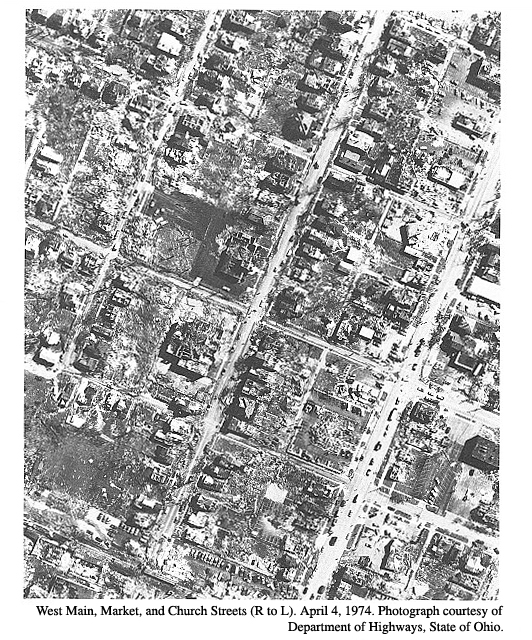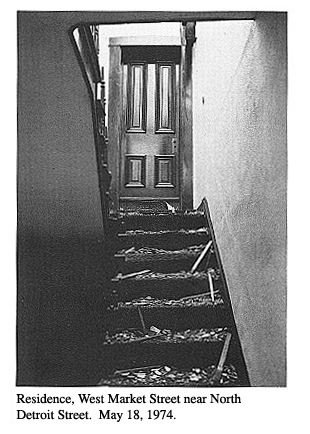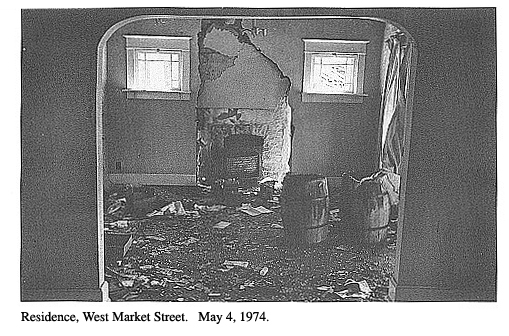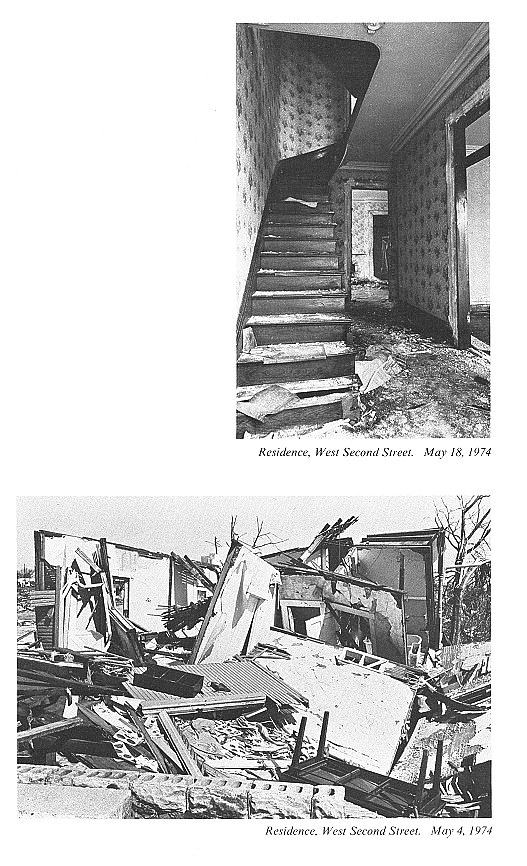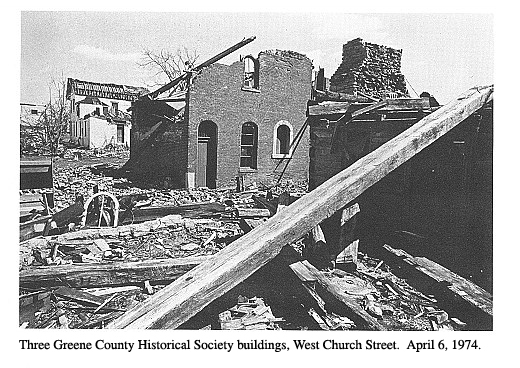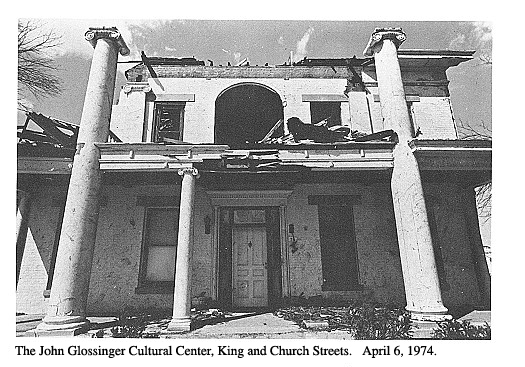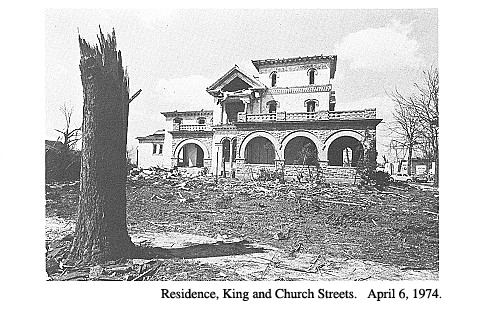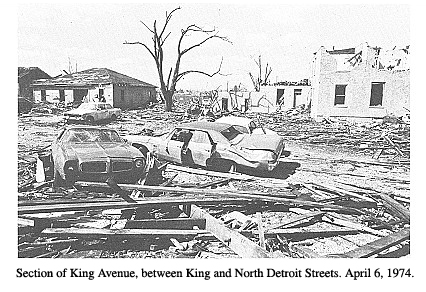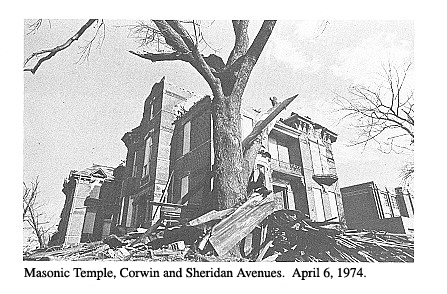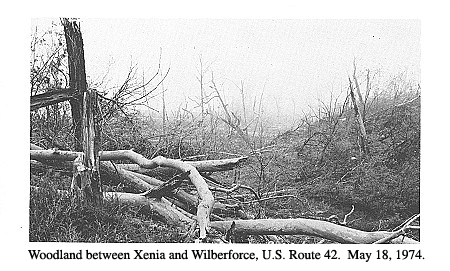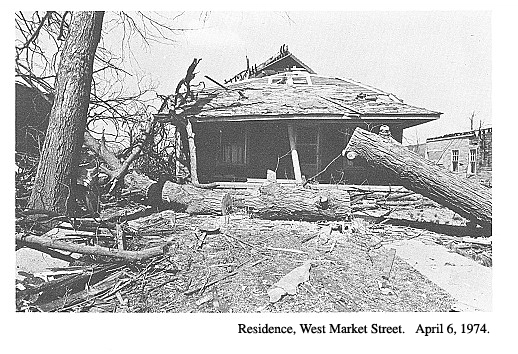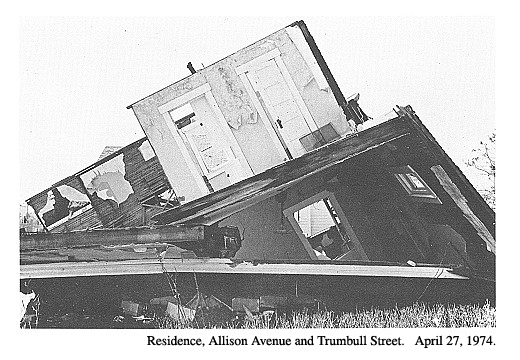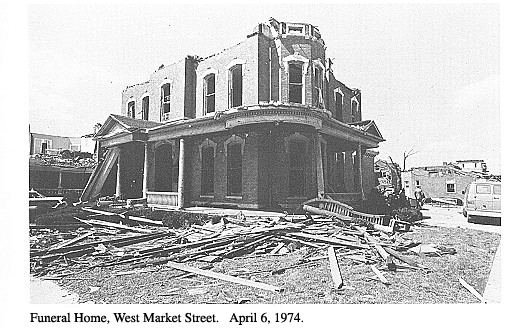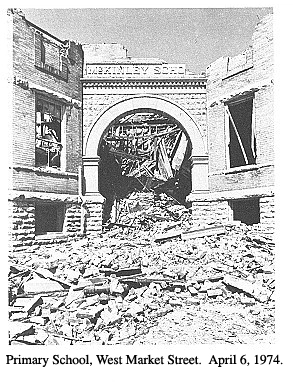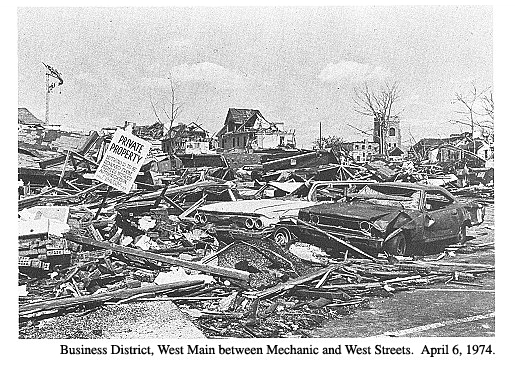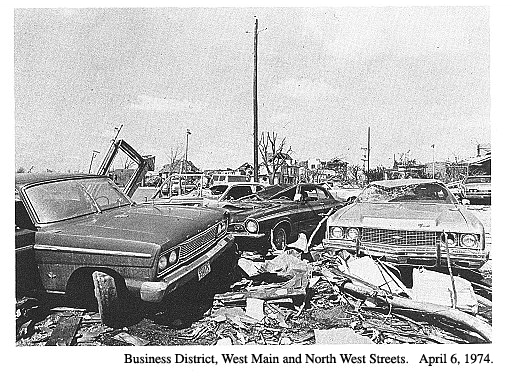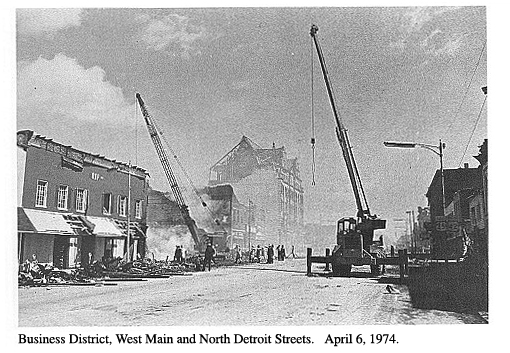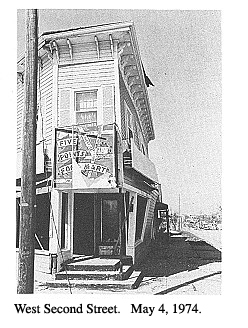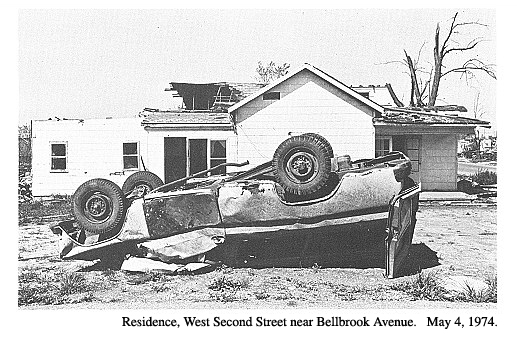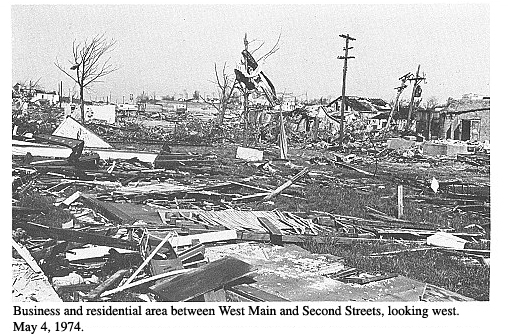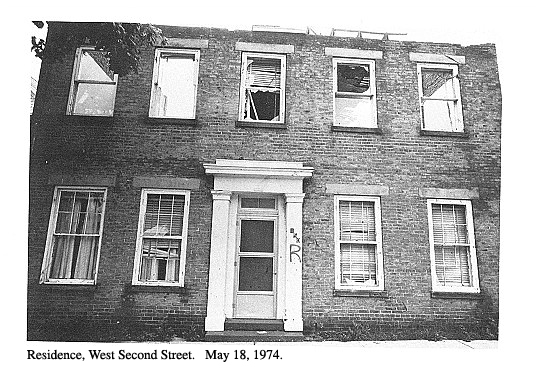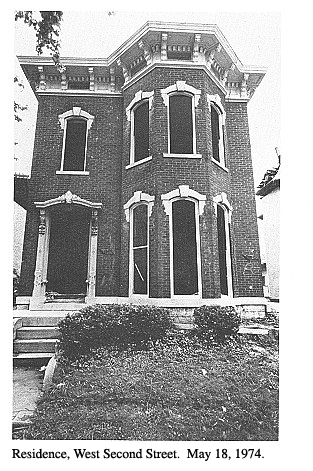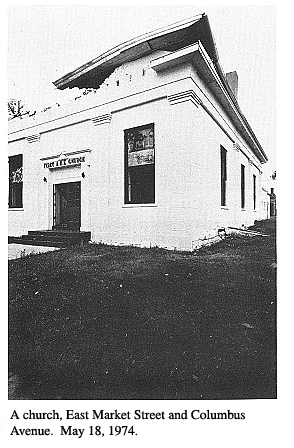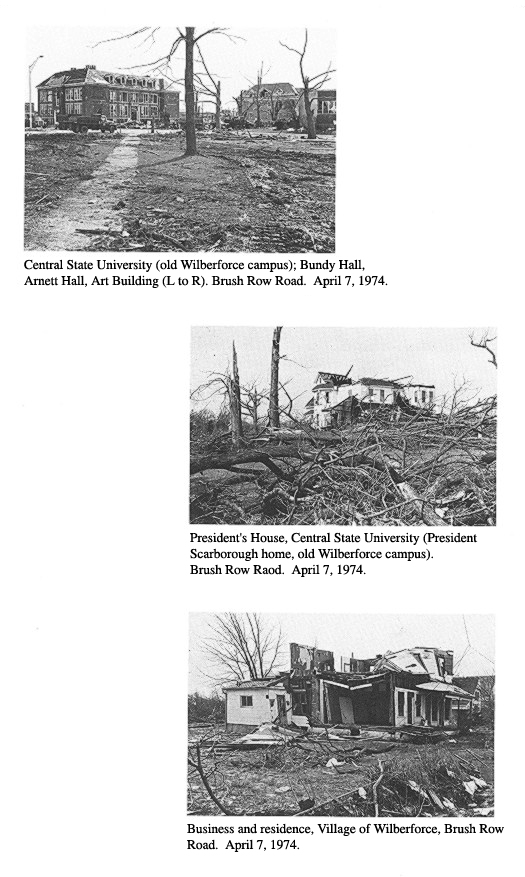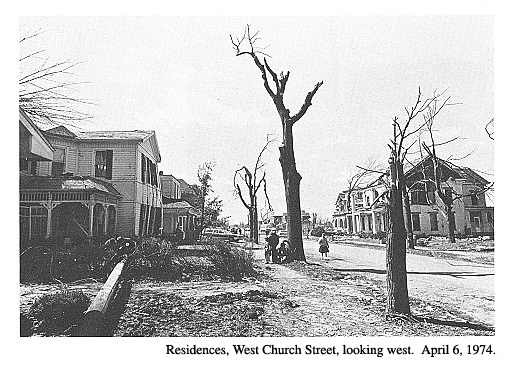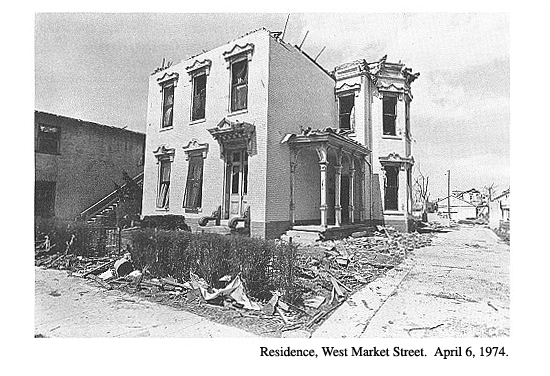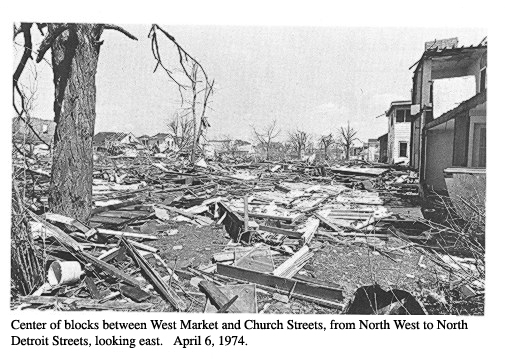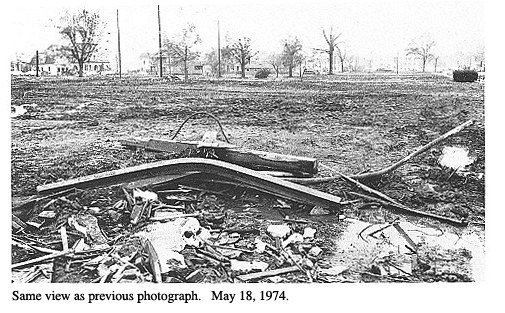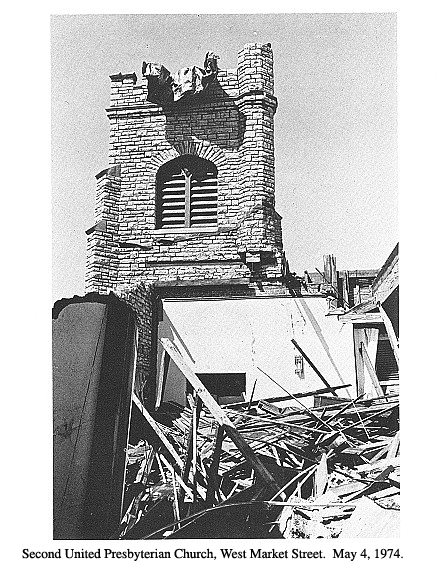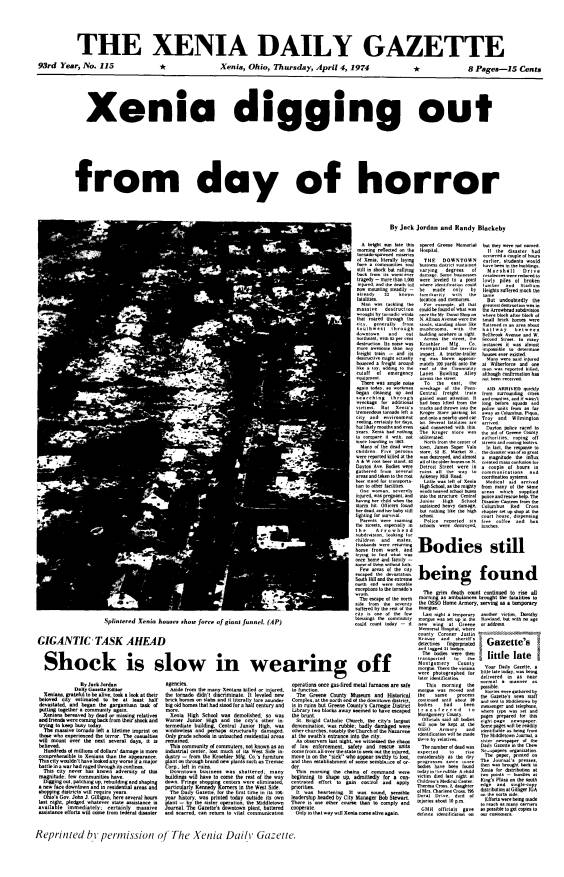Ohio History Journal
- 1
- 2
- 3
- 4
- 5
- 6
- 7
- 8
- 9
- 10
- 11
- 12
- 13
- 14
- 15
- 16
- 17
- 18
- 19
- 20
edited by
DONALD A. HUTSLAR
Crossroads: The Xenia Tornado,
A Retrospective
View
It is possible to factually document the
cataclysmic tornado which cut a path
through southwestern Ohio on the third
of April 1974. Pictures can show the de-
struction; words convey the impressions
of the participants. There will be many
publications of this nature. What is
difficult, perhaps impossible, to impart is the
break in historic continuity such an
event will produce, particularly in a community
such as Xenia. What is meant by
"historic continuity"?
A village or city can be considered as
an entity of infinite parts, some definable,
some forever inexplicable. The
structures and residents can be statistically
analyzed, photographed to the smallest
detail, but the important element-the es-
sence of the community-can never be
completely captured in words or pictures.
This essence is understood best by those
who have lived their lifetimes in or near an
urban environment. Buildings are
appreciated for their memories as well as for
their functions; certain streets are
passages for reflection, others simply connect
points on a map; a single tree, an old
stone sidewalk, an odd chimney pot-each
might rekindle a half-forgotten event,
an indistinctly remembered story told by a
grandparent.
This, then, is what is meant by historic
continuity. It is an interaction of thought
and object, and is conveyed from one
generation to the next. The gradual altera-
tion of a community through growth and
reconstruction does not necessarily disrupt
the continuity between the townspeople
and their surroundings. Nor probably is
this continuity as severely disturbed as
one might think by man-made disasters such
as war. The dangers of destruction are
apprehended, and there is a local or na-
tional conscience desirous of preserving
objects and memories of cultural impor-
tance. There are cities in Europe which
have faced such crises many times.
The sudden destruction of a city by an
unforeseen event such as an earthquake,
tornado, or fire is different, however.
The gradual alteration of a building cannot
be remarked, the growth of trees
remembered, or old memories relived in the face of
impending ruin, as might occur during a
war. When sudden destruction occurs, the
youngest generation might retain
memories, yes-but immature as children are, the
significance of the structures and
scenes relative to their historical continuity will be
unknown to them, so cannot be passed on
to the next generation. It does not mat-
ter if a new house of 1974 stands
exactly on the foundations of a nineteenth century
Mr. Hutslar is Associate Curator of History. The Ohio Historical Society. He was the
photographer
for all the scenes
except the aerial views.
Crossroads 193
house. The events and names associated
with the old residence can never be trans-
ferred to the new-and are therefore soon
forgotten, or relegated to the two-dimen-
sional page of a history book, if
remembered at all.
The purpose of this word-and-picture
essay is to record the few weeks between
the destruction by a tornado of much of
the older section of the city of Xenia and of
Wilberforce (present Central State University)
and the razing of the damaged build-
ings. It is a final glimpse of many once
familiar scenes. Incomplete certainly;
meagre, perhaps, but well intentioned.
The reminiscences of Xenia quoted on these
pages are excerpted from the book Ohio
Town (1962) by permission of the pub-
lisher, The Ohio State University Press.
This book, which deserves to be read by
all, was written by Helen Hooven
Santmyer, who has known Xenia and its citizens
since the early 1900's. She has conveyed
the continuity of life in Xenia from its
founding to the near present in both a
factual and reflective manner seldom equal-
led in local historical writing.
The outward changes that have come in my
time-new streets, new houses, the many
new people-these are minor and
unimportant; it is not because of them that the town is im-
measurably richer than when I was a
child. It is the added years that make it so, the years
lived out in its houses, its streets:
the town is richer by the life of a generation ... the roofs of
the town have sheltered an added
half-century of birth, of childhood, of growing up and fall-
ing in love-of growing old and dying:
all the hard, sometimes bitter but always rewarding
experience of being men and women. (p.
309)
Only three of the structures that appear
prominently in the following photographs are
still standing at the publication of
this article. The "Eli Millen" house, page 198, is largely
restored. Bundy and Arnett Halls at
Central State University, page 207, are awaiting recon-
struction. In the City of Xenia, as of
June 25, 1974, damage reports had been filed on 3400
to 3500 structures; an additional 1427
structures had been razed. Of this last figure, 1098
were single family residences. In case
future historic archaeologists are interested, the bulk
of the debris from Xenia is buried in a
quarry at 39° 48' 45.6" latitude, 83° 59' 24.6"
longi-
tude. U.S.G.S. topographic map, 7.5'
series, "Yellow Springs Quadrangle."
|
Most towns that grew up around the right-angled intersection of two roads have kept for generations to the pattern of a cross, however lopsided and misshappen. Lesser streets that parallel the original two were never quite so long, and at the outermost intersections, close to the courthouse square, were four corners of pasture and meadow land. Now every town has expanded to fill those empty spaces, but housing projects spread first and farthest along those two main streets, and so the cross is after a fashion preserved. (p. 293) |
|
The young among us some- times rebel in their inexperience, saying "nothing ever happens here." They say it because they do not know the old houses. If they live long enough they will learn that everything has happened here, and may happen again ... But however many of the old houses stand today, to remind us of another time, no one can ever write a book based on the lives that have been spent under their roofs. ... A stranger would not dare imagine the preposterous kind of thing that has happened here. Nor would invention serve the native who is familiar with the pat- tern of events: your tale might be so |
|
unbelieveable as to make you feel safe, yet someone would surely point to a door, a parlor window, a side porch, and say: "How did you know? I thought everyone was dead who might have remembered...." (pp. 79-80) |
|
|
|
To him who for a lifetime has walked in the shade of certain walls or dodged the rain- drops falling from certain eaves, whose thumbs have pressed the same latches, whose palms have turned the same doorknobs, whose feet have crossed the same thresholds times beyond number-to him, mass and line, texture of brick and stone, the movement of the sun across a wall, are so familiar as to be noted with an abstracted eye, and accepted without question. (p. 25) |
|
More numerous than [the] mid-century houses are the fantastic Victorian villas of the sixties, seventies, and eighties, with their balconies and pinnacles and towers, their mansard roofs patterned with particolored slates. Andrew Baughman's has been rebuilt ... but on the corner about it is Eli Millen's home, worsened by the heavy Teutonic porch of boulders arched like a Romanesque cloister that was added by a later owner. (p. 75) |
|
|
|
On the next street to the west is Andrew Baughman's old house, where he lived before he built his villa next door. Once his farmyard went all the way to the creek on the north, and to Detroit Street on the east, and what was then his lane is now a narrow street.... this short passageway, joining King Street and Detroit, with not a house facing it, is "King Ave- nue." (pp. 69-70) |
|
|
|
The largest, most fantastic of the mansions built in the 1870's was the Roberts Villa ... When we were children, there used to be picture postcard views of the Roberts Villa (always capitalized) for sale in all the drugstores. We children were consumed with curiosity about the place, but went no further to gratify it than to climb the fence and creep through the long grass to a vantage point under one of the tentlike maple trees, whence we would stare, seeing nothing but blind windows that flamed in the sunset.... the Roberts sisters are forgotten; part of their land is now the park. ... A street goes where the carriage drive used to be, and the mansion itself is the Masonic Temple. (pp. 77-78) |
|
|
|
There were two patches of woodland beyond the Robertses' pastures and tilled fields; you could follow the creek bank almost all the way there. The first wood was perhaps a couple of miles from town. Here in their season bloomed all kinds of violets: yellow, white, and purple; and anemones, May apples, Jacob's ladder, wild geranium, Dutchman's breeches, white and red trillium-in and under and among the saplings and bramblebushes that made an almost impenetrable underbrush beneath the tall high-branched trees. (p. 297) |
|
A number of other large houses, nondescript in architecture, sprawling and comfort- able, were built in the nineties and early 1900's, filling the gaps in the old streets, until the last vacant lot, grass-grown and weedy, had been used. Between all these and among them are smaller houses, old and moderately old, shabby or immaculate in new paint; in odd cor- ners, down crooked alleys are tucked away the very small houses .... There are no new houses within the limits of the old town: the bright new houses are in the bright new (but treeless) subdivisions. (p. 79) |
|
These houses are safe only so long as they are handed down from one generation to another of the families that built them. On Market Street, . .. is the one that we knew most intimately once upon a time, because the grandchildren who lived there were our close friends; and there we once had slumber parties and pillow fights, taffy-pulls in the kitchen, and marshmallow roasts around the marble fireplace of the back living room. That house is now a funeral home. (p. 71) |
|
There was the third grade, when you first went to the new McKinley school and to a young teacher of whose inexperience you took advantage. Whether the pic- ture you still see is of one day or of day-after-day you can't be sure now, but it is ineradicable: a noisy room- ful of children in motion, where chalk, erasers, spitballs, and wet sponges filled the air, and where there was running in the aisles with splashing inkwells held like base- balls. (p. 170) |
|
|
|
In all these years our business district has not changed greatly in extent: it has spread hardly at all, except for scattered filling stations, used-car and parking lots where old houses have been torn down to make way for them. (p. 46) |
|
The streets are quieter again, now that the horses are gone, although they are much busier: there are few of those long-houred afternoons when nothing stirs in the great width of the two main streets.... But we never became reconciled to the blatancy of chain-store fronts, red and green and yellow. Then, just as it seemed there were more and more of these moving in, making of the town one ugliness, our native businesses-banks, building and loan companies, furni- ture stores-either built anew or rebuilt their facades, so that it is perhaps true to say that our business section has never been so dignified or handsome, nor looked so prosperous. (p. 47) |
|
|
|
Beyond the first block of Main Street, west as far as the railroad crossing, there are few shops, but the houses are coming down one by one, and the trees-the tall maples and the great-girthed sycamores-by the half-dozen at a time, to make way for parking and used- car lots and filling stations. (Any native still averts his eyes from what has been done to Main Street beyond the railroad crossing, where the new four-lane highway to Dayton be- gins: every tree sacrificed; a bleak, barren stretch of houses with no front yards, where once shade lay solid, and inside the fences cottages were hidden behind lilacs and sweet-shrub bushes. (p. 62) |
|
Being torn down, it [the house] stands now in our mind's eye as it was in its perfection, beautiful and gracious, and for a long while will be remembered so. It may be that all the men and women of all the generations who dwelt in these houses would have felt the same way; if so, we should lament only the town's loss of dignity and of its air of venerable age when one comes down, instead of feeling sad that a house should so long outlast the pos- sessive love of a family that there was no one left to preserve it. (p. 64) |
|
|
|
|
|
Then, in the fifties, a Negro university [Wilberforce], with the Cincinnatian Salmon P. Chase as one of its founders and trustees, was established not far from town, and thereafter more free Negroes came to live in the community, drawn by the hope and the chance of edu- cating their children. (p. 88) |
|
Valentines in a drugstore window, the smell of roasting coffee, sawdust on the butcher's floor-there comes a time in middle age when even the critical mind is almost ready to admit that these are as good to have known and remembered, associated as they are with friendliness between man and man, between man and child, as fair streets and singing towers and classic arcades. (p. 50) |
|
A stranger driving through does not really see our houses, except here and there, in glimpses: the maples are too thick, the branches hang too low. But it comes as something of a shock to the mind to realize, when you begin to describe them, that you are in almost the same position: not since you grew up have you walked the length of any but the home streets, or seen any except your friends' houses, and those briefly between curb and doorstep. . . You are aware that the streets have not altered much in the years between: mass and weight and chiaroscuro are right and familiar, and any change calls attention to itself, but to describe the houses more definitely you must go back in your memory to the days when you went on foot, and peered through a long succession of iron fences as you passed. (pp. 53-54) |
|
|
|
Now, when you are growing old, you go to church.... You go seeking what would once seemed not worth the recapture: that peace so profound that it came close to being boredom-that utter and abiding security that you knew when, sitting between your grand- mother and mother, you dreamed your dreams undisturbed through Sunday morning after drowsy Sunday morning. The substance of those dreams you have forgotten ... but you do remember how good and how tranquil they left you feeling .... Nevertheless, you find- sometimes-what you have sought: remembering, your mind becomes again innocent and quiet, loving God, the earth, and the fullness thereof.... (p. 156) |
edited by
DONALD A. HUTSLAR
Crossroads: The Xenia Tornado,
A Retrospective
View
It is possible to factually document the
cataclysmic tornado which cut a path
through southwestern Ohio on the third
of April 1974. Pictures can show the de-
struction; words convey the impressions
of the participants. There will be many
publications of this nature. What is
difficult, perhaps impossible, to impart is the
break in historic continuity such an
event will produce, particularly in a community
such as Xenia. What is meant by
"historic continuity"?
A village or city can be considered as
an entity of infinite parts, some definable,
some forever inexplicable. The
structures and residents can be statistically
analyzed, photographed to the smallest
detail, but the important element-the es-
sence of the community-can never be
completely captured in words or pictures.
This essence is understood best by those
who have lived their lifetimes in or near an
urban environment. Buildings are
appreciated for their memories as well as for
their functions; certain streets are
passages for reflection, others simply connect
points on a map; a single tree, an old
stone sidewalk, an odd chimney pot-each
might rekindle a half-forgotten event,
an indistinctly remembered story told by a
grandparent.
This, then, is what is meant by historic
continuity. It is an interaction of thought
and object, and is conveyed from one
generation to the next. The gradual altera-
tion of a community through growth and
reconstruction does not necessarily disrupt
the continuity between the townspeople
and their surroundings. Nor probably is
this continuity as severely disturbed as
one might think by man-made disasters such
as war. The dangers of destruction are
apprehended, and there is a local or na-
tional conscience desirous of preserving
objects and memories of cultural impor-
tance. There are cities in Europe which
have faced such crises many times.
The sudden destruction of a city by an
unforeseen event such as an earthquake,
tornado, or fire is different, however.
The gradual alteration of a building cannot
be remarked, the growth of trees
remembered, or old memories relived in the face of
impending ruin, as might occur during a
war. When sudden destruction occurs, the
youngest generation might retain
memories, yes-but immature as children are, the
significance of the structures and
scenes relative to their historical continuity will be
unknown to them, so cannot be passed on
to the next generation. It does not mat-
ter if a new house of 1974 stands
exactly on the foundations of a nineteenth century
Mr. Hutslar is Associate Curator of History. The Ohio Historical Society. He was the
photographer
for all the scenes
except the aerial views.
(614) 297-2300
